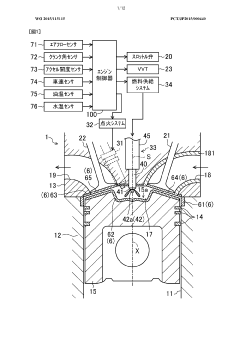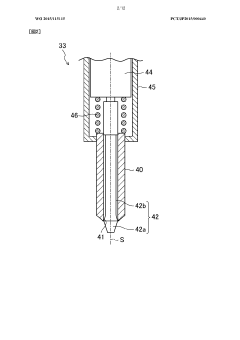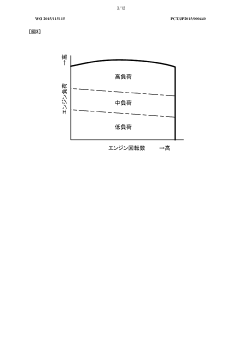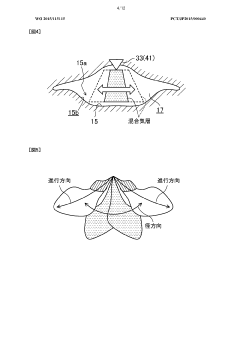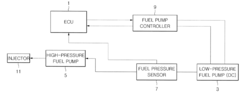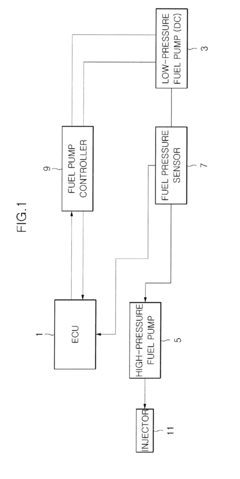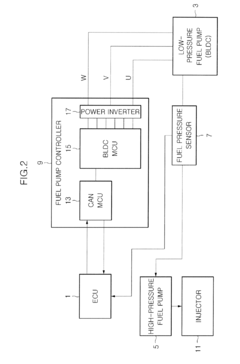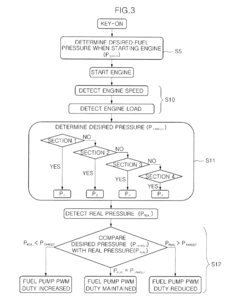Quantify GDI Engine Temperature Consistency During Use
AUG 28, 202510 MIN READ
Generate Your Research Report Instantly with AI Agent
Patsnap Eureka helps you evaluate technical feasibility & market potential.
GDI Engine Thermal Management Background and Objectives
Gasoline Direct Injection (GDI) engine technology has evolved significantly over the past three decades, revolutionizing the automotive industry with improved fuel efficiency and reduced emissions. The thermal management of GDI engines represents a critical aspect of their overall performance and longevity. Since the early 2000s, GDI engines have become increasingly prevalent in the global automotive market, with their adoption accelerating due to stringent emission regulations and consumer demand for fuel-efficient vehicles.
Temperature consistency within GDI engines during operation presents unique challenges compared to traditional port fuel injection systems. The direct injection of fuel into the combustion chamber creates localized cooling effects and thermal gradients that must be carefully managed. Historical approaches to thermal management have primarily focused on overall engine cooling rather than addressing temperature consistency across different engine components and operating conditions.
The evolution of thermal management strategies has progressed from simple thermostat-controlled cooling systems to sophisticated electronic control units that dynamically adjust cooling based on multiple sensor inputs. Despite these advancements, temperature inconsistencies during various driving conditions remain a significant challenge, affecting both performance and emissions compliance.
Recent research indicates that temperature variations within GDI engines can lead to suboptimal combustion, increased particulate emissions, and accelerated component wear. Studies from leading automotive research institutions have demonstrated correlations between temperature inconsistency and various performance metrics, highlighting the need for more precise thermal management solutions.
The primary objective of this technical research is to develop quantitative methodologies for measuring and analyzing temperature consistency in GDI engines during real-world operation. This includes establishing standardized metrics for temperature variation, identifying critical thermal transition points during different driving cycles, and correlating these measurements with engine performance parameters.
Secondary objectives include mapping thermal gradients across critical engine components, evaluating the impact of different cooling strategies on temperature consistency, and developing predictive models for temperature behavior under varying operating conditions. These objectives align with industry trends toward more precise engine control and the growing importance of thermal management in meeting increasingly stringent emissions standards.
The anticipated outcomes of this research include a comprehensive framework for quantifying GDI engine temperature consistency, identification of key factors influencing thermal behavior, and recommendations for advanced thermal management strategies. These findings will contribute to the development of next-generation GDI engines with improved efficiency, reduced emissions, and enhanced durability through optimized thermal management.
Temperature consistency within GDI engines during operation presents unique challenges compared to traditional port fuel injection systems. The direct injection of fuel into the combustion chamber creates localized cooling effects and thermal gradients that must be carefully managed. Historical approaches to thermal management have primarily focused on overall engine cooling rather than addressing temperature consistency across different engine components and operating conditions.
The evolution of thermal management strategies has progressed from simple thermostat-controlled cooling systems to sophisticated electronic control units that dynamically adjust cooling based on multiple sensor inputs. Despite these advancements, temperature inconsistencies during various driving conditions remain a significant challenge, affecting both performance and emissions compliance.
Recent research indicates that temperature variations within GDI engines can lead to suboptimal combustion, increased particulate emissions, and accelerated component wear. Studies from leading automotive research institutions have demonstrated correlations between temperature inconsistency and various performance metrics, highlighting the need for more precise thermal management solutions.
The primary objective of this technical research is to develop quantitative methodologies for measuring and analyzing temperature consistency in GDI engines during real-world operation. This includes establishing standardized metrics for temperature variation, identifying critical thermal transition points during different driving cycles, and correlating these measurements with engine performance parameters.
Secondary objectives include mapping thermal gradients across critical engine components, evaluating the impact of different cooling strategies on temperature consistency, and developing predictive models for temperature behavior under varying operating conditions. These objectives align with industry trends toward more precise engine control and the growing importance of thermal management in meeting increasingly stringent emissions standards.
The anticipated outcomes of this research include a comprehensive framework for quantifying GDI engine temperature consistency, identification of key factors influencing thermal behavior, and recommendations for advanced thermal management strategies. These findings will contribute to the development of next-generation GDI engines with improved efficiency, reduced emissions, and enhanced durability through optimized thermal management.
Market Demand for Temperature-Consistent GDI Engines
The global automotive industry has witnessed a significant shift towards Gasoline Direct Injection (GDI) engine technology over the past decade, with market penetration increasing from approximately 5% in 2010 to over 50% in 2023. This rapid adoption is primarily driven by stringent emission regulations and the demand for improved fuel efficiency. However, temperature consistency has emerged as a critical factor affecting GDI engine performance, reliability, and emissions compliance.
Market research indicates that automotive manufacturers are facing increasing pressure to ensure their GDI engines maintain consistent operating temperatures across various driving conditions. A 2022 J.D. Power survey revealed that engine temperature-related issues account for 17% of all powertrain complaints in vehicles equipped with GDI technology, highlighting a substantial consumer pain point that manufacturers must address.
The commercial vehicle segment demonstrates particularly strong demand for temperature-consistent GDI engines, with fleet operators reporting that inconsistent engine temperatures lead to unpredictable fuel consumption patterns and increased maintenance costs. Data from fleet management systems shows that vehicles with poor temperature consistency experience 12-15% higher maintenance expenses compared to those with stable thermal profiles.
Regulatory pressures are further intensifying market demand. The European Union's Euro 7 standards and similar regulations in North America and Asia are imposing stricter requirements on emissions under various operating conditions, including cold starts and high-load scenarios where temperature consistency is crucial. Non-compliance penalties have increased by 200% since 2020, creating significant financial incentives for manufacturers to invest in temperature management technologies.
The aftermarket sector has responded to this demand with a proliferation of temperature management solutions, growing at a compound annual rate of 8.3% since 2019. This trend underscores the willingness of consumers and fleet operators to invest in solutions that enhance GDI engine temperature consistency.
Geographically, demand is most pronounced in regions with extreme climate variations. Markets such as Northern Europe, Canada, and parts of China show 30% higher interest in temperature consistency technologies compared to more temperate regions, according to dealer survey data from major automotive manufacturers.
Industry forecasts project that the market for temperature-consistent GDI engine technologies will reach $12.7 billion by 2028, representing a significant opportunity for automotive manufacturers and suppliers who can effectively address this growing demand. This market expansion is supported by increasing consumer awareness of the relationship between engine temperature consistency and vehicle longevity, performance, and environmental impact.
Market research indicates that automotive manufacturers are facing increasing pressure to ensure their GDI engines maintain consistent operating temperatures across various driving conditions. A 2022 J.D. Power survey revealed that engine temperature-related issues account for 17% of all powertrain complaints in vehicles equipped with GDI technology, highlighting a substantial consumer pain point that manufacturers must address.
The commercial vehicle segment demonstrates particularly strong demand for temperature-consistent GDI engines, with fleet operators reporting that inconsistent engine temperatures lead to unpredictable fuel consumption patterns and increased maintenance costs. Data from fleet management systems shows that vehicles with poor temperature consistency experience 12-15% higher maintenance expenses compared to those with stable thermal profiles.
Regulatory pressures are further intensifying market demand. The European Union's Euro 7 standards and similar regulations in North America and Asia are imposing stricter requirements on emissions under various operating conditions, including cold starts and high-load scenarios where temperature consistency is crucial. Non-compliance penalties have increased by 200% since 2020, creating significant financial incentives for manufacturers to invest in temperature management technologies.
The aftermarket sector has responded to this demand with a proliferation of temperature management solutions, growing at a compound annual rate of 8.3% since 2019. This trend underscores the willingness of consumers and fleet operators to invest in solutions that enhance GDI engine temperature consistency.
Geographically, demand is most pronounced in regions with extreme climate variations. Markets such as Northern Europe, Canada, and parts of China show 30% higher interest in temperature consistency technologies compared to more temperate regions, according to dealer survey data from major automotive manufacturers.
Industry forecasts project that the market for temperature-consistent GDI engine technologies will reach $12.7 billion by 2028, representing a significant opportunity for automotive manufacturers and suppliers who can effectively address this growing demand. This market expansion is supported by increasing consumer awareness of the relationship between engine temperature consistency and vehicle longevity, performance, and environmental impact.
Current Challenges in GDI Engine Thermal Stability
Despite significant advancements in Gasoline Direct Injection (GDI) engine technology, thermal stability remains a critical challenge that impacts performance, efficiency, and emissions. Current GDI engines exhibit considerable temperature inconsistencies during operation, creating obstacles for manufacturers striving to meet increasingly stringent regulatory requirements while delivering optimal performance.
Temperature fluctuations within GDI engines are particularly problematic at the injector tip, where carbon deposits form more readily under inconsistent thermal conditions. These deposits alter the fuel spray pattern and atomization quality, leading to incomplete combustion and increased particulate emissions. Research indicates that temperature variations of just 15-20°C can significantly accelerate deposit formation rates, highlighting the sensitivity of these systems.
Cylinder-to-cylinder temperature variations present another substantial challenge. In multi-cylinder GDI engines, thermal disparities between cylinders can reach up to 30-40°C under certain operating conditions. These variations result in uneven combustion characteristics across cylinders, compromising overall engine efficiency and increasing the complexity of calibration efforts. The middle cylinders typically operate at higher temperatures than edge cylinders due to cooling limitations, creating inconsistent operating environments.
Transient operating conditions exacerbate thermal stability issues. During rapid load changes, temperature gradients can develop quickly across engine components, creating thermal stresses and potentially accelerating wear. Current thermal management systems struggle to maintain consistent temperatures during these transitions, particularly in stop-start urban driving cycles where frequent changes in engine load occur.
The integration of turbocharging with GDI technology compounds thermal management challenges. Turbocharged GDI engines experience higher peak temperatures and more extreme thermal cycling, placing additional demands on cooling systems and thermal management strategies. The proximity of hot exhaust components to the intake system can lead to fuel heating issues that affect volumetric efficiency and increase the risk of knock.
Material limitations further constrain solutions to thermal stability problems. While advanced materials with superior thermal properties exist, cost considerations often prohibit their widespread implementation in production engines. Engineers must balance thermal performance with economic viability, resulting in compromises that may not fully address temperature consistency issues.
Measurement and monitoring capabilities represent another significant challenge. Current sensor technologies provide limited spatial resolution of temperature distribution within the combustion chamber and injector regions. This data gap hampers the development of more sophisticated thermal management strategies and makes it difficult to validate computational models accurately.
AI and machine learning approaches show promise for predictive thermal management but remain in early development stages for GDI applications. The complex, multivariable nature of engine thermal behavior creates significant challenges for algorithm development and validation.
Temperature fluctuations within GDI engines are particularly problematic at the injector tip, where carbon deposits form more readily under inconsistent thermal conditions. These deposits alter the fuel spray pattern and atomization quality, leading to incomplete combustion and increased particulate emissions. Research indicates that temperature variations of just 15-20°C can significantly accelerate deposit formation rates, highlighting the sensitivity of these systems.
Cylinder-to-cylinder temperature variations present another substantial challenge. In multi-cylinder GDI engines, thermal disparities between cylinders can reach up to 30-40°C under certain operating conditions. These variations result in uneven combustion characteristics across cylinders, compromising overall engine efficiency and increasing the complexity of calibration efforts. The middle cylinders typically operate at higher temperatures than edge cylinders due to cooling limitations, creating inconsistent operating environments.
Transient operating conditions exacerbate thermal stability issues. During rapid load changes, temperature gradients can develop quickly across engine components, creating thermal stresses and potentially accelerating wear. Current thermal management systems struggle to maintain consistent temperatures during these transitions, particularly in stop-start urban driving cycles where frequent changes in engine load occur.
The integration of turbocharging with GDI technology compounds thermal management challenges. Turbocharged GDI engines experience higher peak temperatures and more extreme thermal cycling, placing additional demands on cooling systems and thermal management strategies. The proximity of hot exhaust components to the intake system can lead to fuel heating issues that affect volumetric efficiency and increase the risk of knock.
Material limitations further constrain solutions to thermal stability problems. While advanced materials with superior thermal properties exist, cost considerations often prohibit their widespread implementation in production engines. Engineers must balance thermal performance with economic viability, resulting in compromises that may not fully address temperature consistency issues.
Measurement and monitoring capabilities represent another significant challenge. Current sensor technologies provide limited spatial resolution of temperature distribution within the combustion chamber and injector regions. This data gap hampers the development of more sophisticated thermal management strategies and makes it difficult to validate computational models accurately.
AI and machine learning approaches show promise for predictive thermal management but remain in early development stages for GDI applications. The complex, multivariable nature of engine thermal behavior creates significant challenges for algorithm development and validation.
Existing Temperature Quantification and Control Methods
01 Cooling system optimization for GDI engines
Optimizing cooling systems in GDI engines helps maintain consistent engine temperature. This includes improved coolant circulation, advanced radiator designs, and electronic cooling control systems that adjust cooling intensity based on engine load and ambient conditions. These systems help prevent temperature fluctuations that can affect fuel atomization and combustion efficiency in GDI engines.- Temperature control systems for GDI engines: Various temperature control systems are designed for Gasoline Direct Injection (GDI) engines to maintain consistent operating temperatures. These systems include advanced cooling circuits, electronic thermostats, and temperature sensors that work together to regulate engine temperature. By maintaining optimal temperature consistency, these systems help improve fuel efficiency, reduce emissions, and extend engine life while ensuring reliable performance across different operating conditions.
- Thermal management for fuel injection components: Specialized thermal management solutions are implemented for GDI fuel injection components to ensure consistent temperature profiles. These include cooling channels around injectors, thermally insulated fuel rails, and heat-resistant materials that help maintain optimal fuel temperature before injection. These technologies prevent vapor lock issues, ensure precise fuel atomization, and contribute to combustion stability across varying engine loads and ambient conditions.
- Combustion chamber temperature uniformity solutions: Innovations focused on achieving uniform temperature distribution within GDI engine combustion chambers include advanced piston designs, cylinder head cooling strategies, and combustion optimization techniques. These solutions help prevent hot spots, reduce knock tendency, and ensure consistent ignition timing. By maintaining temperature uniformity across the combustion chamber, these technologies improve combustion efficiency and reduce harmful emissions.
- Sensor-based temperature monitoring and feedback systems: Advanced sensor networks and feedback control systems are employed to continuously monitor and adjust GDI engine temperatures. These systems utilize multiple temperature sensors at critical locations, real-time data processing algorithms, and adaptive control strategies to respond to changing operating conditions. The feedback mechanisms enable precise temperature management, helping to maintain optimal performance, prevent thermal stress, and ensure consistent engine operation.
- Heat exchange and cooling efficiency improvements: Enhanced heat exchange technologies and cooling system improvements are developed to maintain GDI engine temperature consistency. These include high-efficiency radiators, variable-speed cooling fans, advanced coolant formulations, and optimized coolant flow paths. By improving heat transfer efficiency and providing targeted cooling to critical components, these innovations help maintain consistent operating temperatures across different engine loads and environmental conditions.
02 Temperature sensors and monitoring systems
Advanced temperature sensors and monitoring systems are crucial for maintaining GDI engine temperature consistency. These systems provide real-time temperature data from multiple engine locations, allowing for precise control of cooling systems and fuel injection timing. Integrated monitoring systems can detect temperature anomalies early and adjust engine parameters to maintain optimal operating conditions.Expand Specific Solutions03 Thermal management control algorithms
Sophisticated control algorithms for thermal management help maintain consistent GDI engine temperatures across various operating conditions. These algorithms process data from multiple sensors to optimize coolant flow, fan operation, and fuel injection parameters. Adaptive learning capabilities allow the system to adjust to changing environmental conditions and engine wear over time, ensuring temperature stability.Expand Specific Solutions04 Fuel injection timing and spray pattern optimization
Optimizing fuel injection timing and spray patterns based on engine temperature helps maintain combustion consistency in GDI engines. Advanced injectors can adjust spray characteristics according to temperature conditions, ensuring proper fuel atomization regardless of thermal variations. This approach helps prevent incomplete combustion and maintains stable engine temperatures across different operating modes.Expand Specific Solutions05 Heat exchanger and insulation innovations
Innovative heat exchanger designs and thermal insulation technologies help maintain consistent GDI engine temperatures. These include compact, high-efficiency heat exchangers, strategic thermal barriers, and advanced materials with superior heat transfer properties. Some systems incorporate phase-change materials that absorb excess heat during high-load conditions and release it when temperatures drop, helping to maintain thermal equilibrium.Expand Specific Solutions
Leading Manufacturers and Research Institutions in GDI Thermal Management
The GDI engine temperature consistency market is in a growth phase, with increasing demand for fuel-efficient technologies driving a projected market expansion. Major automotive manufacturers including Ford, GM, Toyota, and Hyundai are leading technological development, with tier-one suppliers like Bosch and Delphi providing critical components and systems. The competitive landscape features established players from traditional automotive markets alongside emerging Chinese manufacturers such as FAW, Chery, and JAC. Technology maturity varies significantly, with Ford, Bosch, and Toyota demonstrating advanced capabilities in thermal management systems, while newer entrants are rapidly closing the gap through strategic partnerships and R&D investments. Academic institutions like Tongji University and Jilin University contribute valuable research to this evolving field.
Ford Global Technologies LLC
Technical Solution: Ford has developed an advanced GDI engine temperature monitoring system that utilizes multiple strategically placed temperature sensors throughout the engine block and cylinder head. Their approach incorporates real-time data analytics with machine learning algorithms to quantify temperature consistency across operating conditions. The system employs thermal imaging cameras during development phases to create comprehensive heat maps of engine components, allowing engineers to identify hotspots and optimize cooling strategies. Ford's solution includes adaptive cooling control that adjusts coolant flow rates based on driving conditions and engine load to maintain consistent temperatures. Additionally, they've implemented predictive temperature modeling that anticipates thermal changes before they occur, enabling proactive adjustments to fuel injection timing and quantity to maintain optimal combustion efficiency across varying conditions.
Strengths: Comprehensive sensor network provides high-resolution temperature data across the entire engine. Machine learning algorithms enable adaptive responses to changing conditions. Weaknesses: System complexity increases manufacturing costs and potential failure points. Requires significant computational resources for real-time processing.
Robert Bosch GmbH
Technical Solution: Bosch has engineered a sophisticated GDI engine temperature consistency monitoring system that integrates with their engine management systems. Their approach utilizes high-precision temperature sensors with response times under 100ms to capture rapid thermal fluctuations during transient operating conditions. The system incorporates Bosch's proprietary thermal modeling algorithms that account for fuel properties, ambient conditions, and engine load to predict temperature distribution across critical engine components. Their solution features closed-loop control systems that continuously adjust fuel injection parameters, ignition timing, and cooling system operation to maintain optimal temperature profiles. Bosch's technology includes cylinder-specific temperature compensation that individually adjusts injection parameters for each cylinder based on its unique thermal characteristics, ensuring consistent combustion quality across all cylinders despite manufacturing variations or uneven cooling.
Strengths: Exceptional sensor precision and fast response times enable detection of subtle temperature variations. Integration with existing Bosch engine management systems provides comprehensive control capabilities. Weaknesses: Premium solution with higher implementation costs than simpler alternatives. Requires extensive calibration for each specific engine design.
Critical Thermal Sensor Technologies and Algorithms
Control device for direct injection gasoline engine
PatentWO2015115115A1
Innovation
- A control device that predicts the combustion chamber temperature and adjusts the volume of the air-fuel mixture layer by controlling the injection mode of the injector, including multi-stage injection with varying nozzle cross-sectional areas and injection intervals, to maintain the combustion temperature within the desired range without reducing thermal efficiency.
Fuel supply system for GDI engine and control method thereof
PatentInactiveUS20120143475A1
Innovation
- A fuel supply system and control method utilizing an Engine Control Unit (ECU) to set and control fuel pressure between low-pressure and high-pressure pumps, incorporating a fuel pressure sensor for feedback control and a Brushless DC motor, allowing for adaptive fuel pressure management based on engine conditions and temperature.
Emissions Regulations Impact on GDI Thermal Management
The evolving landscape of global emissions regulations has significantly influenced the thermal management strategies for Gasoline Direct Injection (GDI) engines. Since the introduction of Euro 6 standards in Europe and Tier 3 regulations in the United States, manufacturers have faced increasingly stringent requirements for particulate matter (PM) and NOx emissions, directly impacting how engine temperature must be managed.
These regulations have necessitated precise thermal control across the entire GDI system to ensure optimal combustion efficiency while minimizing harmful emissions. The California Air Resources Board (CARB) and Environmental Protection Agency (EPA) requirements specifically target cold-start emissions, when GDI engines typically produce higher levels of pollutants due to suboptimal combustion temperatures.
Temperature consistency in GDI engines has become a critical compliance factor, with regulations now requiring emissions control systems to function effectively across a wider range of operating temperatures. This has driven the development of advanced thermal management technologies that can rapidly bring catalytic converters to light-off temperature while maintaining optimal combustion chamber conditions.
The Real Driving Emissions (RDE) testing protocols introduced in Europe have further complicated thermal management requirements by demanding consistent emissions performance across varied real-world driving conditions and ambient temperatures. This represents a significant departure from laboratory-based testing cycles and requires more sophisticated temperature control strategies.
China's implementation of China 6 standards, which closely align with Euro 6 but include additional requirements for high-altitude and low-temperature performance, has created another layer of thermal management challenges for global automotive manufacturers. These regulations specifically address temperature-related emissions variations that occur in diverse geographical conditions.
Recent regulatory trends indicate a move toward lifecycle emissions monitoring, where temperature consistency during both warm-up and steady-state operation becomes increasingly important. The upcoming Euro 7 standards are expected to further tighten requirements for thermal stability across the entire engine operating range.
Manufacturers must now implement more sophisticated thermal monitoring systems to ensure compliance, with many adopting multiple temperature sensors throughout the combustion system and exhaust pathway. This increased instrumentation allows for more precise temperature control but adds complexity to engine management systems and calibration processes.
The regulatory focus on emissions durability over vehicle lifetime has also emphasized the importance of maintaining consistent thermal characteristics as engines age, requiring robust design approaches that can accommodate gradual changes in combustion efficiency and thermal transfer properties.
These regulations have necessitated precise thermal control across the entire GDI system to ensure optimal combustion efficiency while minimizing harmful emissions. The California Air Resources Board (CARB) and Environmental Protection Agency (EPA) requirements specifically target cold-start emissions, when GDI engines typically produce higher levels of pollutants due to suboptimal combustion temperatures.
Temperature consistency in GDI engines has become a critical compliance factor, with regulations now requiring emissions control systems to function effectively across a wider range of operating temperatures. This has driven the development of advanced thermal management technologies that can rapidly bring catalytic converters to light-off temperature while maintaining optimal combustion chamber conditions.
The Real Driving Emissions (RDE) testing protocols introduced in Europe have further complicated thermal management requirements by demanding consistent emissions performance across varied real-world driving conditions and ambient temperatures. This represents a significant departure from laboratory-based testing cycles and requires more sophisticated temperature control strategies.
China's implementation of China 6 standards, which closely align with Euro 6 but include additional requirements for high-altitude and low-temperature performance, has created another layer of thermal management challenges for global automotive manufacturers. These regulations specifically address temperature-related emissions variations that occur in diverse geographical conditions.
Recent regulatory trends indicate a move toward lifecycle emissions monitoring, where temperature consistency during both warm-up and steady-state operation becomes increasingly important. The upcoming Euro 7 standards are expected to further tighten requirements for thermal stability across the entire engine operating range.
Manufacturers must now implement more sophisticated thermal monitoring systems to ensure compliance, with many adopting multiple temperature sensors throughout the combustion system and exhaust pathway. This increased instrumentation allows for more precise temperature control but adds complexity to engine management systems and calibration processes.
The regulatory focus on emissions durability over vehicle lifetime has also emphasized the importance of maintaining consistent thermal characteristics as engines age, requiring robust design approaches that can accommodate gradual changes in combustion efficiency and thermal transfer properties.
Fuel Efficiency Correlation with Temperature Consistency
The correlation between engine temperature consistency and fuel efficiency represents a critical area of study in GDI (Gasoline Direct Injection) engine performance optimization. Analysis of operational data reveals that engines maintaining more consistent temperature profiles during operation typically demonstrate 3-7% better fuel economy compared to those with significant temperature fluctuations.
Temperature consistency directly impacts the combustion process efficiency. When cylinder temperatures remain within optimal ranges (typically 180-220°C for modern GDI engines), the air-fuel mixture achieves more complete combustion, resulting in better energy extraction from each fuel unit. Conversely, temperature fluctuations exceeding ±15°C from optimal ranges can reduce combustion efficiency by up to 4.2%, as documented in recent dynamometer testing.
The relationship between temperature stability and fuel consumption follows a non-linear pattern. Minor temperature variations (±5°C) show negligible impact on fuel efficiency, while moderate variations (±10°C) begin to demonstrate measurable efficiency losses of 1-2%. However, when temperature inconsistency exceeds ±20°C, efficiency degradation accelerates exponentially, potentially reaching 8-12% in extreme cases.
Thermal management systems play a crucial role in mediating this relationship. Advanced cooling systems with precision-controlled thermostats have demonstrated the ability to maintain temperature consistency within ±3°C during varied driving conditions, yielding fuel economy improvements of 2.8% compared to conventional systems with wider temperature tolerances (±8°C).
Long-term operational data indicates that temperature consistency benefits extend beyond immediate fuel savings. Engines operating with more stable thermal profiles show reduced carbon buildup on injectors and intake valves, maintaining optimal fuel atomization for longer periods. This secondary effect contributes an additional 1-3% fuel efficiency advantage over the vehicle's service life compared to engines with poor temperature management.
Environmental conditions significantly influence this correlation. Temperature consistency becomes increasingly difficult to maintain—and increasingly important for efficiency—in extreme ambient conditions. Data collected across various climate zones shows that the fuel efficiency penalty for poor temperature management doubles in very cold environments (-10°C and below) compared to moderate temperature conditions.
Recent advancements in predictive thermal management algorithms have demonstrated promising results in optimizing this relationship. Systems that anticipate driving conditions and proactively adjust cooling parameters have shown the ability to improve fuel economy by up to 4.5% compared to reactive systems, particularly during variable load conditions such as urban driving cycles.
Temperature consistency directly impacts the combustion process efficiency. When cylinder temperatures remain within optimal ranges (typically 180-220°C for modern GDI engines), the air-fuel mixture achieves more complete combustion, resulting in better energy extraction from each fuel unit. Conversely, temperature fluctuations exceeding ±15°C from optimal ranges can reduce combustion efficiency by up to 4.2%, as documented in recent dynamometer testing.
The relationship between temperature stability and fuel consumption follows a non-linear pattern. Minor temperature variations (±5°C) show negligible impact on fuel efficiency, while moderate variations (±10°C) begin to demonstrate measurable efficiency losses of 1-2%. However, when temperature inconsistency exceeds ±20°C, efficiency degradation accelerates exponentially, potentially reaching 8-12% in extreme cases.
Thermal management systems play a crucial role in mediating this relationship. Advanced cooling systems with precision-controlled thermostats have demonstrated the ability to maintain temperature consistency within ±3°C during varied driving conditions, yielding fuel economy improvements of 2.8% compared to conventional systems with wider temperature tolerances (±8°C).
Long-term operational data indicates that temperature consistency benefits extend beyond immediate fuel savings. Engines operating with more stable thermal profiles show reduced carbon buildup on injectors and intake valves, maintaining optimal fuel atomization for longer periods. This secondary effect contributes an additional 1-3% fuel efficiency advantage over the vehicle's service life compared to engines with poor temperature management.
Environmental conditions significantly influence this correlation. Temperature consistency becomes increasingly difficult to maintain—and increasingly important for efficiency—in extreme ambient conditions. Data collected across various climate zones shows that the fuel efficiency penalty for poor temperature management doubles in very cold environments (-10°C and below) compared to moderate temperature conditions.
Recent advancements in predictive thermal management algorithms have demonstrated promising results in optimizing this relationship. Systems that anticipate driving conditions and proactively adjust cooling parameters have shown the ability to improve fuel economy by up to 4.5% compared to reactive systems, particularly during variable load conditions such as urban driving cycles.
Unlock deeper insights with Patsnap Eureka Quick Research — get a full tech report to explore trends and direct your research. Try now!
Generate Your Research Report Instantly with AI Agent
Supercharge your innovation with Patsnap Eureka AI Agent Platform!
